Between July 9 and 11, the Portuguese scientific community gathered in Carcavelos – more specifically at Nova SBE – for Encontro Ciência 2025. As in previous editions, INESC TEC participated with seven speakers representing the Institute in different sessions; the institution also reached 1st place in the Arquivo.pt award and the presentation of a scientific poster.
More than 2,000 participants attended over 50 parallel sessions and five plenaries and had the opportunity to visit the event’s science and technology exhibition, all over three days.
Shall we go through the timeline?
July 9 – shaping the future through impactful science: international partnerships and a nomination
“FCT Partnerships with American Universities: Shaping the Future through Impactful Science” was the name of the parallel session featuring and organised by the three existing international partnerships between FCT and North American universities. INESC TEC, which hosts the UT Austin Portugal programme in Portugal, was present at this session attended by Fernando Alexandre, Minister for Education, Science and Innovation.
The moment served as an opportunity to present the next phase of international partnerships while reflecting on the legacy they have built in the country and worldwide over almost two decades.
In addition to Minister Fernando Alexandre and José Manuel Mendonça, other speakers included João Magalhães, National Co-Director of CMU Portugal, who delivered the opening remarks, and John Hansman, North American Co-Director for MIT Portugal, who moderated a discussion panel featuring Paulo Dimas (CMU Portugal), Hélder Silva (MIT Portugal) and John Ekerdt (UT Austin Portugal).
July 10 – a debate/dinner and a presentation by the Chairman
Four presentations took place at an exclusive working dinner that brought together representatives from MECI, the European Commission, FCT and CCDRs, among others. Before dinner, Minister Fernando Alexandre and Marc Lemaître, Director-General of the Directorate-General for Research and Innovation (DG RTD) at the European Commission, opened the event, followed by four pitches – two from R&D institutions and two from companies. INESC TEC, represented by João Claro, the Institute’s Chairman, was (along with the Gulbenkian Institute of Molecular Biology) one of the speakers representing the Portuguese scientific system.
July 11 – three morning sessions and five INESC TEC speakers
The morning of July 11 was qyute busy for INESC TEC researchers attending Encontro Ciência 2025. Three parallel sessions featured five speakers from the Institute; let’s break it down.
“Saúde de precisão: o papel da tecnologia na medicina personalizada” – this session, organised by INESC TEC, filled the Fundação Amélia de Mello auditorium.
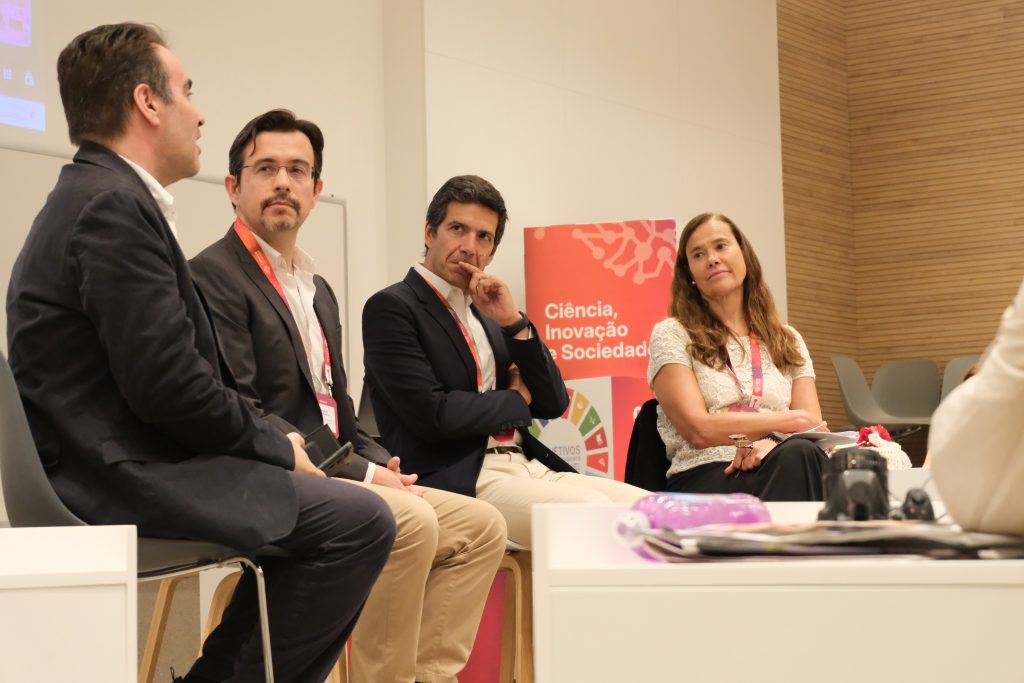
“Precision health represents a paradigm shift in modern medicine, focusing on prediction, prevention and personalised care tailored to individual variability in genes, environment and lifestyle. At the heart of this transformation lies rapid technological advancement, which enables the collection, integration and analysis of vast datasets to inform clinical decision-making,” explained Artur Rocha, INESC TEC researcher and coordinator of the Human-Centred Computing and Information Science area, who moderated the debate.
The discussion panel included Hugo Paredes, also an INESC TEC researcher and coordinator in the same area, Miguel Coimbra, INESC TEC researcher in Biomedical Engineering, Henrique Barros, president of ISPUP and Full Professor at FMUP, and Ivone Silva, physician and Head of Department at ULS de Santo António and Visiting Full Professor at ICBAS.
For an hour and a half, they debated the potential of emerging technologies, access to certain treatments, the efficiency and effectiveness of healthcare systems, shared examples of real progress being made nationally and internationally – favouring a dialogue between researchers and healthcare professionals, promoting scientific literacy and bringing science closer to society.
Miguel Coimbra stressed that although many technological challenges remain, there is already mature technology in use in some hospitals, citing examples such as IPO-Porto and the Unidade Local de Saúde Gaia/Espinho. Ivone Silva emphasised that the focus of technology on healthcare must meet the three main premises: prevention, prediction and personalisation. Henrique Barros explained that patient segmentation by disease has driven progress in many fields and that in cancer treatment “we are now where we were a hundred years ago with infectious diseases. Thirty years from now, when people hear the term cancer, they will be hearing different terminology. Our goal must be to increase our quality of life – and be able to afford it,” he stressed.
According to Hugo Paredes, it is crucial that these technologies are taught at universities from the start, to enhance professionals’ capabilities rather than replace them. Addressing the audience’s question about potential replacement, Ivone Silva was clear: “robots will not replace doctors, but we doctors will have more time to be human.”
Regarding priorities for the next five years, there was broad agreement among the speakers. The physician from ULS de Santo António highlighted the need for national interoperable structures and shared access to health data, which currently exist only in the public network but should be extended to the private sector. Hugo Paredes restated that “education is an investment in the future and in empowering people. Everything else can follow from that, but it is important that everyone works towards the same goal, which is only possible if they do not perceive technology as a threat.” Miguel Coimbra stressed the need for technology certification so that competition is not driven solely by financial capacity.
The session concluded with Artur Rocha emphasising words such as “interdisciplinarity, ethics, literacy” as fundamental factors to achieve precision health.
In the room opposite, Filipe Neves dos Santos, INESC TEC researcher in agricultural robotics and head of the Institute’s TRIBE Lab – Robotics and IoT Laboratory for Smart Precision Agriculture and Forestry – joined the session “IA como agente transformador do setor agroalimentar”, with speakers from INESC TEC, INESC ID, UTAD, Sumol+Compal and MC/Sonae.
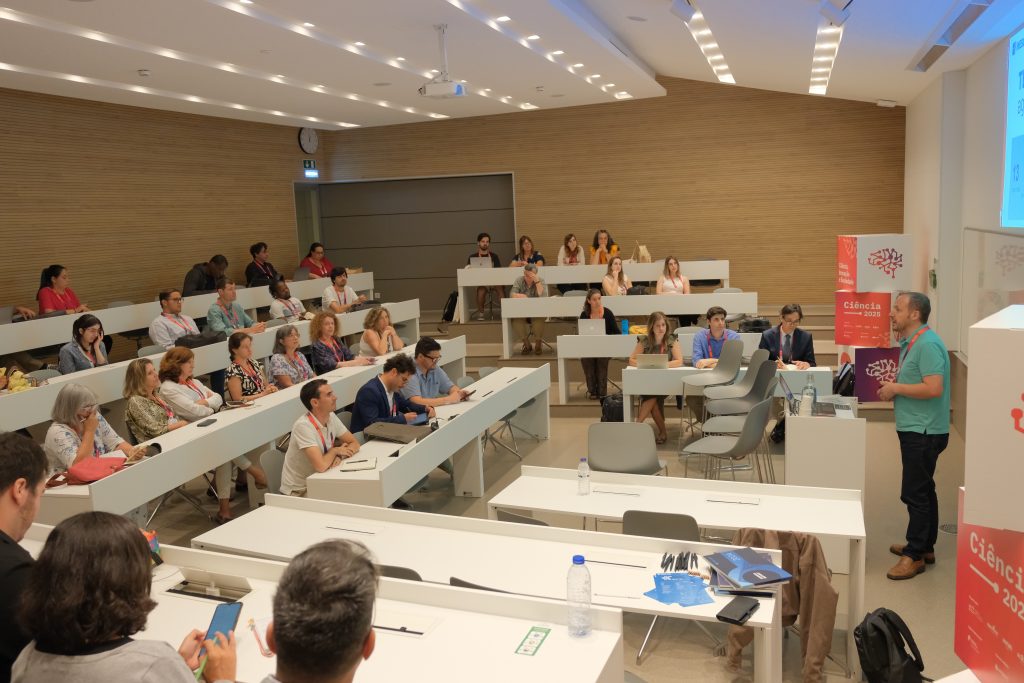
Filipe Neves dos Santos presented INESC TEC’s progress in robotics applied to agriculture, mentioning several past and ongoing projects, but mainly stressing the importance of making technology accessible to farmers. A concrete example was when he noted that many farmers use iPhones rather than Android devices, which “force” them to adapt technology originally designed for the latter. He shared this example in the context of a project for a type of grape harvest that cannot be mechanised: “We couldn’t use robots in these cases, so we developed a concept where, by connecting a smartphone to a pair of scissors and a bucket, the farmer can still carry out manual harvesting, but more effectively and efficiently, while also accessing vineyard productivity maps,” he told the audience.
Looking ahead, Filipe Neves dos Santos explained that INESC TEC researchers working in this area aim, among other goals, to develop robots and other technologies, including IoT solutions, that adapt to nature.
A few metres further down the corridor, João Claro, Chariman of INESC TEC, was speaking in the session “Laboratórios Associados e o futuro do conhecimento: impacto, liberdade e responsabilidade”. The moderator posed two main questions: “What is the distinctive role of Associated Laboratories and what are the implications?” and “In today’s political context of misinformation and the politicisation of science, what is the role of Associated Laboratories?”
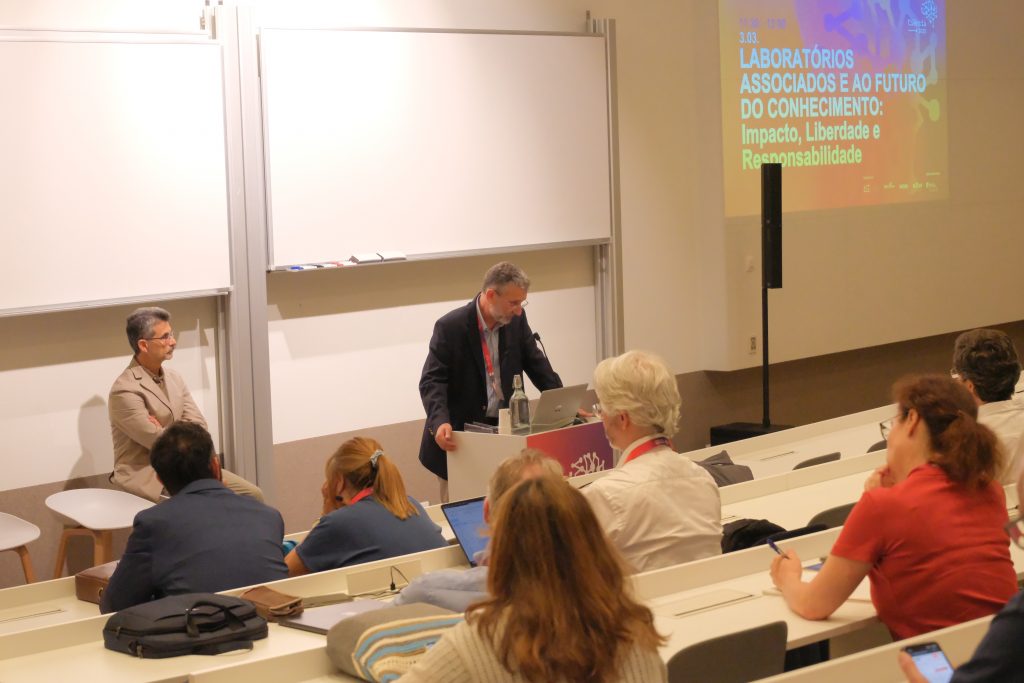
João Claro highlighted, in response to the first question, contributions to public policies as a distinctive element of INESC TEC’s practice, citing as an example the work carried out by the Foresight and Public Policies Office; and, in the second question, the principles that have always guided the Institute’s activity, namely the commitment to communication, integrity and independence, illustrated by the work carried out after the recent blackout of April 28, 2025.
July 11 – an afternoon with another session and a first-place award
The Institute’s participation concluded on the afternoon of July 11, just before the event closed. “O papel da investigação na resiliência, autonomia estratégica e defesa na EU” was the title of the session organised by INESC-ID, which brought together various actors from the INESC ecosystem: INESC Coimbra, INESC ID, INESC INOV, INESC MN and INESC TEC.
João Claro, Chairman INESC TEC, opened the session by presenting the conclusions of the Summer Meeting that had gathered the entire INESC ecosystem in Brussels earlier that month. In fact, during this session, he revealed that the report with the main conclusions of the event had just been made available. Six thematic axes structured the debate: alignment of European defence technology programmes; the role of R&D organisations in dual-use innovation; strategic foresight; strengthening Europe’s resilience through dual-use technologies; and the strategic foundations of the 10th Framework Programme. The conclusions highlighted consolidated advances, emerging priorities – such as organisational readiness, integrated dual-use processes and more flexible funding mechanisms – and persistent challenges, including regulatory and market fragmentation, as well as the need for strategic orchestration.
They point to the importance of sustained collective action, greater policy coherence and cross-sector partnerships to strengthen Europe’s technological sovereignty.
In the same session, Nuno Cruz, INESC TEC researcher and coordinator of the robotics and autonomous systems area, delivered the presentation “Da investigação à autonomia estratégica da EU”. He focused on marine robotics, highlighting the new challenges posed by dual-use considerations, INESC TEC’s strategy and capabilities in this field – from infrastructure to the portfolio of expertise and technology – and concrete examples of projects addressing these challenges, such as SEAGUARD and NAUTILUS.
According to the INESC TEC researcher, robotics plays a leading role in Europe’s strategic autonomy: “Europe has the tools, the expertise and the people. Now, we need coherence and a bold commitment to scale up strategic technologies,” concluded Nuno Cruz.
After the sessions, the event’s closing ceremony began with the awarding of the Arquivo.pt award, with INESC TEC reaching first place. Rúben Almeida, an INESC TEC researcher supervised by Sérgio Nunes and Ricardo Campos (Human-Centred Computing and Information Science and Artificial Intelligence and Decision Support), created the platform A Minha Região – O teu portal autárquico and won the first prize. This digital citizenship tool allows citizens to access municipal election data from 1976 to the present day. The three researchers were called to the main stage of Encontro Ciência 2025, where they received the award from the Minister of Education, Science and Innovation, Fernando Alexandre, and the President of the Board of Directors of the Foundation for Science and Technology (FCT), Madalena Alves.
The event’s Science and Technology Exhibition
Although this year INESC TEC did not participate with a physical stand, it was still represented at the Science and Technology Exhibition of Encontro Ciência 2025. This time, with a digital poster authored by INESC TEC researcher Carlos Rodrigues, entitled “Digital Twin e Validação da Modelação e Simulação Musculoesquelética com Medição In-Vivo das Cargas Internas Articulares por Implantes Instrumentados”.
The results obtained in this work, presented in the poster, highlight the importance of digital twin tools for musculoskeletal modelling and simulation, with applications in the accuracy of planning, intervention and post-operative rehabilitation for total hip and knee arthroplasty, and the need to personalise models based on data from specific patients. They also stress the further development of markerless models for greater convenience without loss of accuracy. Finally, the results of direct in-vivo measurements of joint loads prove to be a highly valuable method for validating MSK-MS models as well as improving post-operative rehabilitation in hip and knee arthroplasty.
The researchers mentioned in this news piece are associated with INESC TEC, the Faculty of Engineering of the University of Porto (FEUP), the Faculty of Sciences of the University of Porto (FCUP), the University of Trás-os-Montes and Alto Douro (UTAD), Universidade da Beira Interior (UBI) and the Universidade Aberta


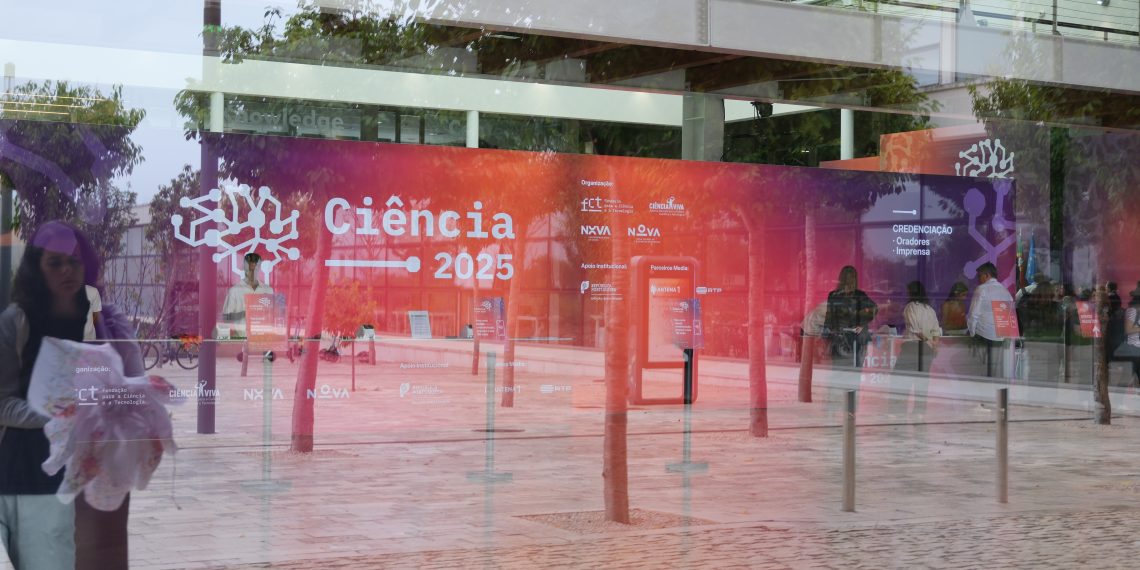
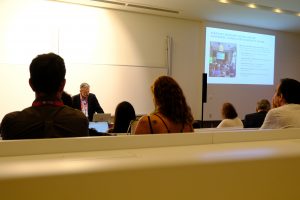
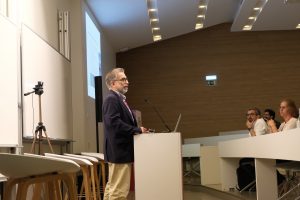
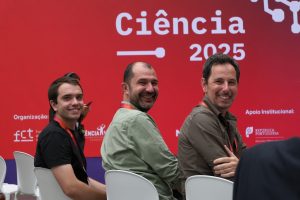
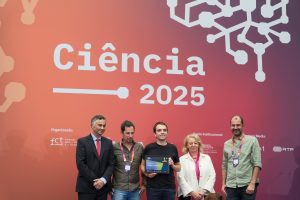
 News, current topics, curiosities and so much more about INESC TEC and its community!
News, current topics, curiosities and so much more about INESC TEC and its community!